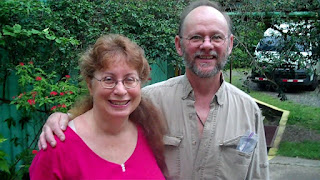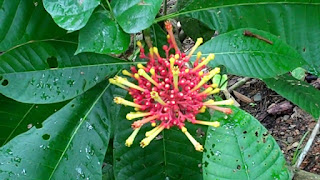Last full day at the Canopy Tower - Thursday, July 30.
Today we got a good, solid taste of the "green season". It rained a little yesterday, and it rained a lot last night. When we got up around 5:30 AM it was not raining. But by the time we were eating breakfast at 7:00, it had started to rain, and it soon became torrential.
The staff ran around shutting windows on the south side of the building. We were scheduled to go to Plantation Road, but it was hopeless. We checked the weather radar, and the storm was huge enough that we knew it would not abate for at least a couple hours. So the departure time and the destination were changed - 8:30 AM to the Miraflores Locks (on the Canal.) Les and I had been there briefly a week or so ago, so we opted to stay at the Tower to do a little writing, record-keeping, reading and studying. Jorge decided to go with the flow, and joined the small group to the Locks.
After lunch we went with our guide Jose to the grounds of the Gamboa Rainforest Resort. Although much of the area is heavily manicured, there are some wilder areas, and a good number of very good birds can be seen. Highlights included more excellent views of White-throated Crakes, a Black-breasted Puffbird, Chestnut-mandibled Toucans, a male Barred Antshrike, a cooperative Jet Antbird and an equally cooperative White-bellied Antbird, Yellow-crowned Tyrannulet, Cinnamon Becard (beautiful bird, and not very common during our travels so far in Panama), Golden-fronted Greenlet, Mangrove Swallows, Blue-black Grosbeak, Giant Cowbird, Yellow-tailed Oriole, Rusty-margined Flycatcher, Social Flycatcher, Lesser Kiskadee.
Today we got a good, solid taste of the "green season". It rained a little yesterday, and it rained a lot last night. When we got up around 5:30 AM it was not raining. But by the time we were eating breakfast at 7:00, it had started to rain, and it soon became torrential.
The staff ran around shutting windows on the south side of the building. We were scheduled to go to Plantation Road, but it was hopeless. We checked the weather radar, and the storm was huge enough that we knew it would not abate for at least a couple hours. So the departure time and the destination were changed - 8:30 AM to the Miraflores Locks (on the Canal.) Les and I had been there briefly a week or so ago, so we opted to stay at the Tower to do a little writing, record-keeping, reading and studying. Jorge decided to go with the flow, and joined the small group to the Locks.
After lunch we went with our guide Jose to the grounds of the Gamboa Rainforest Resort. Although much of the area is heavily manicured, there are some wilder areas, and a good number of very good birds can be seen. Highlights included more excellent views of White-throated Crakes, a Black-breasted Puffbird, Chestnut-mandibled Toucans, a male Barred Antshrike, a cooperative Jet Antbird and an equally cooperative White-bellied Antbird, Yellow-crowned Tyrannulet, Cinnamon Becard (beautiful bird, and not very common during our travels so far in Panama), Golden-fronted Greenlet, Mangrove Swallows, Blue-black Grosbeak, Giant Cowbird, Yellow-tailed Oriole, Rusty-margined Flycatcher, Social Flycatcher, Lesser Kiskadee.
Lesser Kiskadee © 2009 George Griffeth





 We drove in as far as we could, and began the walk. It was not constantly hopping, but we all felt happy and satisfied by the end of the morning.
We drove in as far as we could, and began the walk. It was not constantly hopping, but we all felt happy and satisfied by the end of the morning.






